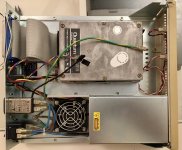The first thing you need to do is verify the power supply is actually working, and working properly. Blindly trusting decades old power supplies with no known history is one of the biggest reasons vintage gear dies. Unplug the hard drive and put a dummy load, like a few fans and measure the voltage. The yellow wire should be +12v and the red wire should be +5v. Both rails should be within 5% of those voltages, if they're outside that range, don't use the supply. The next thing that should be checked is the ripple current, but that requires an oscilloscope. Ripple current is just as important as voltage, you can have a correct voltage, but off the charts ripple current and still kill anything powered by it. Assuming a properly designed SMPS, high ripple is usually caused by old degraded capacitors, which can happen if they sit unused for long periods of time, or are not stored in proper conditions.
If you don't have a way to test the power supply, use another power supply, like an ATX computer supply to power the hard drive, so you have a known good power source.
Assuming you have a known good power source, but the hard drive doesn't spin up, unplug it IMMEDIATELY. If you leave it powered on in a state where the spindle is stuck, you can blow out the motor control IC or damage the motor internally if it doesn't have any protections to shut itself down. Many old drives don't and can kill themselves. Take the drive and turn it on its side and give it a few taps flat on a desk and try powering it up again to see if it spins. You may also try running it upside down. If it runs upside down, it usually means something is wrong with the spindle bearings, like the lube is gummed up. There is no fix for this unfortunately, other than running the drive upside down and hope that the remaining lubrication remixes itself well enough to keep the drive going for awhile.

